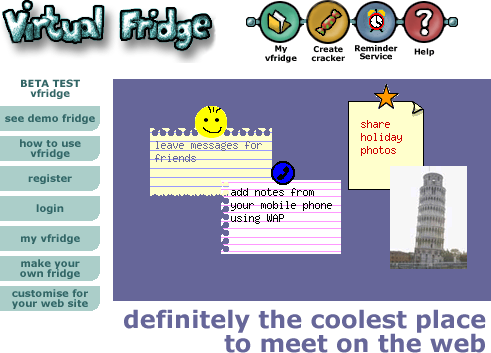|

FireFly - one thousand computers on a Christmas tree

vfridge - a fridge door on the web
abstract
Computers only exist because they do things for people.
From human readable web pages, to formal semantics of linked data and the emergent social semantics of tags and folksonomies, we routinely look to the web as both a source of information and a place to put data. However, the web is also a locus of action: users want to get things done, whether booking a hotel room, or editing an online spreadsheet. The boundaries between web and desktop interaction are blurring. On the one hand, the traditional PC desktop is now inhabited by widgets such as the Mac Dashboard, web fast-download apps such as Java Web Start or Adobe Air, and expanded browser functionality such as Chrome. On the other hand, computation and applications that once were part of the desktop are now hosted on the web (for example word-processing with Google Docs), and various technologies enable web applications to function even when users have no connectivity to the internet. Furthermore, in emerging markets such as India and China, this convergence will be total, as the sole computing experience for many will be through mobile devices and predominantly the web. This talk will explore the premise that this emerging web will be a place of action, not just information, and that the purpose of global data is ultimately to serve human needs.
- This talk is based loosely on a recent paper in the Journal of Web Semantics:
- A. Dix , G. Lepouras, A. Katifori, C. Vassilakis, T. Catarci, A. Poggi, Y. Ioannidis, M. Mora, I. Daradimos, N. Md.Akim, S.R. Humayoun, F. Terella (2010). From the Web of Data to a World of Action. Journal of Web Semantics, Special Issue on Exploring New Interaction Designs Made Possible by the Semantic Web. 8(4), pp. 394-408 http://www.hcibook.com/alan/papers/JWS-2010-world-of-action/
vfridge
reconstructed vfridge at www.vfridge.com (note original 2000 deisgn!)
- Phoenix rises – vfridge online again. blog post June 11, 2010
- Designing a virtual fridge (poster).
Computers and Fun 3, York, 13th December 2000.
appears in Interfaces vol 46 (Spring 2001), pp.10-11
extended abstract || poster || Interfaces 46 (PDF, 1.4Mb) - vfridge – early social networking: why did it fail? slides only (PDF, 154K)
Snip!t
Use it online at www.snipit.org
The project where the idea originated:
- Dix, A., Marshall, J.: At the right time: when to sort web history and bookmarks. In: Proc. of HCI International 2003, vol 1, pp. 758–762 (2003)
But note the observation that people wanted to bookmark portions of web pages was NOT part of the project aims. Although focus is important during research, it is also worth keeping an eye out for other things they sometimes end up being more significant than what you are looking for!
Snip!t is decribed in a number of papers including:
- A. Dix, T. Catarci, B. Habegger, Y. Ioannidis, A. Kamaruddin, A. Katifori, G. Lepouras, A. Poggi, D. Ramduny-Ellis (2006). Intelligent context-sensitive interactions on desktop and the web. Proceedings of the international Workshop in Conjunction with AVI 2006 on Context in Advanced Interfaces. (Venice, Italy, May 23, 2006), ACM Press , pp. 23-27
abstract and paper | ACM DOI - A. Dix (2008). Tasks = data + action + context:
automated task assistance through data-oriented analysis. keynote at Engineering Interactive Systems 2008 , (incorporating HCSE2008 & TAMODIA 2008), Pisa Italy, 25-26 Sept. 2008 .
abstract and links
Personal ontologies and spreading activation
- Katifori, A., Vassilakis, C., Daradimos, I., Lepouras, G., Ioannidis, Y., Dix, A., Poggi, A., Catarci, T.: Personal Ontology Creation and Visualization for a Personal Interaction Management System. In: Workshop on The Disappearing Desktop: Personal Information Management 2008. CHI2008, (2008) [PDF]
- Sauermann, L.: The Gnowsis Semantic Desktop for Information Integration. In: The 3rd Conference on Professional Knowledge Management, pp. 39–42 (2005)
- Katifori, A., Vassilakis, C., Dix, A.: Using Spreading Activation through Ontologies to Support Personal Information Management. In: Common Sense Knowledge and Goal-Oriented Interfaces (CSKGOI 2008) (workshop at 2008 International Conference on Intelligent User Interfaces (IUI 2008). CEUR Workshop Proceedings Vol 323 (2008).
- A. Katifori, C. Vassilakis and A. Dix (2010). Ontologies and the Brain: Using Spreading Activation through Ontologies to Support Personal Interaction. Cognitive Systems Research, 11 (2010) 25–41.
abstract and links - A. Dix, A. Katifori, G. Lepouras, C. Vassilakis and N. Shabir (2010). Spreading Activation Over Ontology-Based Resources: From Personal Context To Web Scale Reasoning. International Journal of Semantic Computing, Special Issue on Web Scale Reasoning: scalable, tolerant and dynamic. 4(1) pp.59-102.
abstract and draft paper | doi: 10.1142/S1793351X10000973 - Anderson, J.: A spreading activation theory of memory. Journal of Verbal Learning and Verbal Behaviour, 22, 261–295 (1983)